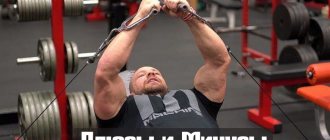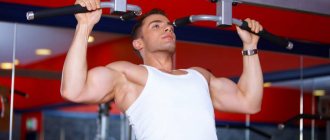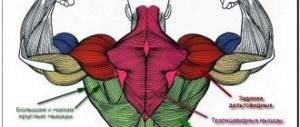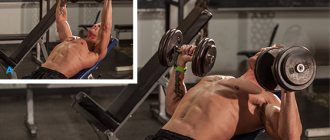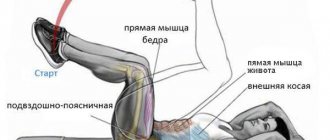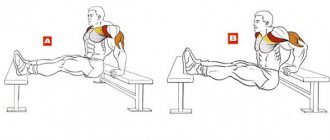Author: Timko Ilya - the ruler of the entire site and fitness trainer | more details >> Rod. 1984 Trained since 1999 Trained since 2007. Author and creator of the site tvoytrener.com. CCM in powerlifting. Champion of Russia and South Russia according to AWPC. Champion of the Krasnodar region according to IPF. 1st category in weightlifting. 2-time winner of the Krasnodar Territory championship in t/a. Author of more than 700 articles on fitness and amateur athletics. Author and co-author of 5 books.
Place in the author rating:
out of competition
(become an author) Date: 2012-05-29 Views: 2,101,772 Rating: 4.7
| All articles by the author >> | Medals articles >> |
Articles are loading...
| Article medals: | article in TOP 10 | more than 1 million views |
Why medals are given to articles:
| Bronze medal: | |
| 1. The article is in the TOP 100 2. The article has more than 3. The article has more than 100 | |
| Silver medal: | |
| 1. The article is in the TOP 50 2. The article has more than 3. The article has more than 500 | |
| Gold medal: | |
| 1. The article is in the TOP 10 2. The article has more than 1 3. The article has more than 1,000 | |
Main muscles - latissimus Additional - pectoralis major and triceps (long head) Difficulty - medium
Load by muscle group
The load is indicated on a 10-point scale (the total load is summed up)
| Latissimus muscles | 8 (high) |
| Breast | 3 (average) |
| Triceps | 3 (average) |
| Total load/exercise type | 14 (weak) / isolated |
Execution options
Pullover with a barbell lying across the bench
A more difficult variation for more advanced athletes. When the projectile is placed behind the head, the pelvis can be lowered down. Additionally, the abdominal and back muscles are involved in the work. It is best to do the exercise in pairs. This allows you to sit on the bench as comfortably as possible, since the projectile is fed by your partner.
Reverse Incline Barbell Pullover
The load falls more on the lower part of the pectoral muscles and on the back. This leads to a reduction in the range of motion and an increase in the load on the elbow joints.
Lying pullover with a barbell: execution technique
Description of the exercise
Some publications write that this is an exercise for the chest muscles. No doubt, the chest also works here, but you won’t pump it up this way. It is advisable to keep your arms less bent than in the picture. The effectiveness of the exercise depends on how far you lower your elbows, not the dumbbell. The exercise is not basic, so it is better to do it at the end of the workout and with a weight that you can do at least 10 times. And no sudden movements! Can also be performed with a barbell or disc. Or you can do it with two dumbbells (one dumbbell in each hand).
Main features
1. Despite the fact that many people do this exercise across the bench, I personally don’t see any advantages in this. Only inconvenience. Therefore, I advise you to lie down completely on the bench (lengthwise), and not invent unnecessary difficulties for yourself.
2. Your arms should be slightly bent throughout the entire movement. If you bend your arms strongly at the bottom, you will turn the pullover into a French press.
3. Remember, this exercise works the chest, back and triceps. And even a little shoulders. Therefore, you will not pump up anything specific with this exercise. But it is great at the end of a workout for a general stretch of the shoulder girdle. In addition, in childhood and adolescence, a pullover causes your chest to expand. Therefore, if you are not yet 18 - 19 years old, then you must do this exercise 1 - 2 times a week.
4. Beginners can use a barbell disc instead of a dumbbell. It's also quite convenient.
5. It is advisable to lower your elbows as low as possible. Not the dumbbell, but the elbows. But not to the point of shoulder pain. And it is advisable to raise it almost to the stomach. Thus, you seem to describe a semicircle.
Technique for performing the exercise, how to do a pullover with a dumbbell correctly
The main principle of performing the exercise is in its name. Pull over is translated from English as “pull from above, pull.” We will pull the muscles of the back and chest to the side of a beautiful, toned body.
There are two types of pullovers:
- Power. Goal: work with muscles. Technique: with slightly bent arms.
- Respiratory. Goal: expansion of the volume of the chest. Technique: with straight arms.
In both cases, the movement is made by the shoulder joints, the elbow joints remain motionless.
The main options for performing the exercise also depend on the surface you use for practicing. This can be a straight horizontal bench, a fitball or an incline bench.
We should also talk about a pullover across a bench without back support. This option is much more difficult to perform, since the muscles of the lower back and abdominals are actively involved. Complexity of execution is often associated with greater efficiency. Is this really so, we’ll figure it out a little lower.
Pullover lying on a horizontal bench
Or a breathing pullover. One of the classic variations. To perform the exercise correctly:
- We take the weight in our hands and lie down completely on the bench.
- Dumbbell in the starting position: place the handle between the thumbs, forming a good grip.
- We lift the dumbbell from the chest, and then smoothly lower it behind the head. We do not bring our arms to the state of a tense bowstring or French press (too bent arms), we maintain a slight bend in the elbow joint.
- Lowering the dumbbell behind your head, take a deep breath and simultaneously bend your pelvis down.
- Let's pause briefly at the bottom point of the trajectory and take another short breath.
- Raise the dumbbell up, exhale, return the pelvis to its original position.
- We exhale forcefully.
You can do:
- in a lying position, with your feet on the floor;
- in a lying position, with your feet on the bench and your feet firmly planted.
The pullover is performed in 2-3 sets of 10-15 repetitions.
For men - the optimal weight load is up to 15 kg, for women - up to 8 kg.
The main purpose of the pullover is to get a good stretch and work with breathing, and not just lift heavy weights.
Video: pullover with dumbbell
Video on how to properly perform a dumbbell pullover
Pullover lying on fitball
The principles of implementation are the same as in the classical scheme. Due to its light springy texture, the fitball helps to relax and stretch the muscles being trained to the maximum. Almost always, exercising with a fitball allows you to feel your body in a new way.
When performing a pullover on a fitball, do not bend your lower back
Pullover lying on a bench with an incline
For maximum impact on the latissimus muscles, it is recommended to perform the pullover on an incline bench, in a head-down position.
Pullover on an incline bench is suitable for experienced athletes
Pullover lying across the bench
In this version, the goals remain the same: stretching and breathing. The emphasis is on working with the back. An obvious advantage is the parallel development of the abdominal muscles. And of course, additional effort to overcome yourself. If you have back problems, this option should be performed with caution or avoided altogether.
- Prepare a dumbbell and lie across the bench. To work, you have two points of support: your legs, bent at an angle of about 90 degrees, and your upper back.
- Place the dumbbell on your chest, grab it and lift it up with your arms slightly bent.
- With a deep breath, begin to lower the dumbbell behind your head, describing an arc.
- At the point of maximum stretch of the latissimus dorsi muscles, lift the dumbbell to the starting position, exhaling as you force.
- The hips remain fixed in one place until the exercise is completed.
When performing a pullover across the bench, choose the weight that is optimal for you
When to expect the effect
If you strictly perform the pullover in accordance with the description and adhere to the training schedule for the week, then the first real results can be seen after 5-6 weeks of active training.
But you should remember that the results will be noticeable faster if you avoid the typical mistakes for this task:
- All movements should be smooth, without jerking. Any sudden movement can cause injury.
- Watch your breathing, it should be deep, otherwise you may experience dizziness.
- The hips must remain motionless, otherwise the load may shift and then the effectiveness of the task at hand will be reduced.
- If you place your hands behind your head too much, you can easily injure your shoulder joint.
- You cannot arch your back, otherwise your lower back will suffer.
- Weight in a pullover is not important, the main thing is technique.
- When drawing up a sports program, you should not include a pullover when working out your shoulders, since the load will be large and not everyone can handle it.
- The head should lie on the bench while performing the classic version, otherwise you can strain your neck.
A pullover is a complex exercise that is aimed at working not only the pectoral muscles, but also forces you to use the shoulder girdle, arms and abs. It is often used to finish off working muscles at the end of a complex workout. To prevent injury and discomfort, be sure to perform the task carefully, start with a light weight and gradually increase it.
Muscles involved
A pullover is an exercise that “pumps up” 2 large muscle groups at once:
- Breasts
- Latissimus dorsi muscles.
In addition, a long triceps bundle is involved in the pullover. The distribution of load between these three muscles varies depending on the range of motion and the angle of the bench.
Active muscles when performing a pullover with dumbbells
The pecs and triceps in the starting position are extremely stretched. They receive 80% of the load during the phase of raising their arms from behind the head and straightening them. Turning to anatomy, we understand that it is impossible to perform such a movement without the participation of these two muscles. It follows that a pullover can be a good “finishing” exercise on chest and arm day.
This isolating exercise is also suitable for “targeted” work of the back muscles: after the hands pass through the vertical, the pectoral and triceps lose “power” and transfer “control” to the lats. Of course, the range for their full involvement in the work is too small, so to properly work out the back muscles, use an inclined bench (position below the horizontal).
Basic mistakes
The most common mistake that beginners make is training with a weight of more than 10 kg. This leads to various consequences, most of which contribute to injury to ligaments, muscles or cartilage. The most effective weights that do not cause any complications are individual and are calculated from the strength indicators and weight of the person. Girls are recommended to take a weight of no more than 10 kg. With improvement of indicators, it can be increased by 2-3 kg.
The dumbbell pullover exercise should not be done with too much bend in the bottom position.
Other common mistakes:
| Error | Description |
| Large bend in the bottom position | Professionals do not advise lowering the body and dumbbell too low. It is also contraindicated to touch the projectile to the floor. Otherwise, the risk of injury increases several times. |
| Pullover bridge | When performing the exercise, strong bending in the lumbar region is prohibited. The same goes for the neck. It is worth remembering that the head must be fixed and pressed against the outside of the bench. |
| Lack of proper breathing | Performing a pullover assumes there is no air retention. Neglecting the rule can cause dizziness and fainting. |
| Feet and hips are not in the correct position | It is not recommended to raise your hips too high or lift your limbs off the floor. This can cause a decrease in the effectiveness of the exercise, thereby increasing the chance of injury. |
Also, you should not perform several approaches a day at once, as this can put unnecessary strain on the muscles, which in most cases leads to damage to muscle tissue. Not pre-warming up before exercise increases the overall risk of injury and damage to joints that have not been warmed up. This often leads to dislocations.
Common mistakes
The most common mistakes made when performing different pullover variations:
- jerking movements performed during the exercise reduce its effectiveness and cause injuries;
- improper breathing, holding it can cause dizziness;
- an increase in the amplitude of movement when the barbell or other projectile is moved excessively behind the head leads to an increase in the level of injury;
- high speed of movements reduces the quality of muscle development;
- lifting the hips during the exercise leads to a shift of the load from the chest area, and therefore reduces the effectiveness of the exercise;
- emphasis on the floor with arching of the back during the “breathing pullover” can lead to a lower back injury;
- alignment of the arms at the elbows during the exercise can provoke a loss of control over the dumbbells and, as a result, shoulder injuries;
- Rocking and sudden tearing movements when performing a pullover with a machine or barbell creates stress for the shoulder joint, or rather its cartilage tissue. A sharp return to the starting position, when the bar of the simulator flies up, in combination with arms straightened at the elbows, leads to the appearance of inflammatory processes;
- using heavy weight implements is a typical mistake for beginners, leading to overload of the shoulders. In a pullover, weight is not the main thing, so at the initial stage of training, a light barbell weighing about 15 kg or a dumbbell of 10 kg will be enough. For beginners who are unsure of their abilities, even when mastering the exercise, it is recommended to perform it with an empty bar to ensure the safety of the shoulder girdle and abs.
One of the typical mistakes that beginners also make is combining pullovers with other exercises to work the shoulder girdle. The pullover is designed to “finish off” the pectoral muscle mass, but not the shoulder muscles. The shoulder joints may not be able to cope with the load received when combining pullovers with other shoulder girdle exercises.
When performing a pullover with dumbbells or a barbell, you should pay special attention to the second part of the exercise, since as you raise your arms, the load on the muscles being worked decreases.
Representing a complex exercise, the pullover involves the muscles of the front of the body, shoulder girdle, arms and abdominals. It is optimally suited for “finishing off” working muscles at the final stage of complex training for both beginners and experienced athletes. To avoid painful injuries during training exercises, beginners should be careful when mastering the pullover with a light weight and avoid sudden movements.
What is the point of the exercise?
Pullover is an isolating bodybuilding exercise aimed at stretching muscles, expanding the volume of the chest, and auxiliary work on the relief. It owes its name to two English words - “pull”, which means to pull, and “over”, that is, upward. As the name confirms, this exercise is based on stretching, while the 2 largest muscle masses located in the back and chest are actively involved.
There are 2 types of pullovers:
- strength – aimed at training muscles and performed on moderately bent arms;
- respiratory – aimed at expanding the volume of the chest, for which it is performed on straightened arms.
When performing both versions of the exercise, the movement is made by the shoulder joints, while the elbow joints remain motionless.
The pullover exercise is traditionally practiced in combination with other exercises. Due to the versatility of this exercise, it can be performed on the day of training the pectoral muscles, as a strength exercise, together with “presses”, on the day of training the spinal muscles, performed together with “tractions” and on the day of training the leg muscles, combining breathing pullovers with squats.
The inclusion of a pullover in training will be especially useful for beginners who have an asthenic physique and a sunken, underdeveloped chest. Correct execution of this exercise promotes the comprehensive development of the chest, stimulates its growth in volume, and allows you to use muscle masses that remain virtually unloaded when performing standard exercises for working the pectoral muscles - arm curls and bench press.
The maximum effect when working out the chest can be achieved by performing the pullover exercise at the age of up to 27 years, while the ideal age category for its practice is 15-20 years, for both boys and girls. At an older age, this exercise will also be useful, although the effect of the deep chest will be less pronounced. By combining pullovers with breathing squats under the age of 20, you can increase the volume of the chest by 3-5 cm.
Barbell or dumbbells?
The bar in your hands allows you to give a harmonious load on the muscles of the arms and chest, while the amplitude of the execution does not change, that is, the arms work the same and the tension on the muscles does not change. When comparing a barbell and a dumbbell in action, the first option has less range and increased flexibility. Dumbbells allow you to create a greater load and bring muscles from static tension to dynamics.
The barbell creates a good load on the pectoral muscles, while dumbbells create a good load on the latissimus dorsi muscles. The benefits of the pullover exercise with a barbell include:
- Improving the ability to carry out loads with the shoulders and active development of the muscles in this area.
- Actively expanding the range of functionality of the shoulder joint and increasing flexibility.
- Positive effect on the development of the pectoralis minor muscle.
- Getting rid of stoop by actively pumping the latissimus muscle. But in the case of back problems, it is better to first consult with specialists and only then create a training program.
- Increasing general physical activity, improving the ability to perform movements.
When choosing a tool for performing exercises, you need to pay attention to convenience and your level of training. It is better for beginner athletes to train with dumbbells, and only then use a barbell.
Pullover exercise: video
Watch the video that shows the technique of doing a pullover to develop the muscles of the chest and back.
Nuances
In order to shift the emphasis to the lats, try doing the pullover while lying on a horizontal bench with your head slightly hanging down. The projectile should be lowered to a depth at which your lats are stretched to the maximum, and raised to the level of the forehead.
This will maintain maximum tension than if you return the bar to chest level. The video below clearly shows how to do this. In addition, doing pullovers this way is great for using the serratus anterior muscle.
Contraindications and possible harm
Before starting any training, consultation with a specialist is required. In some cases, even a simple and accessible exercise can cause serious harm.
So, for example, a pullover is not recommended for those who have the following problems:
- Chronic ailments affecting the back and joints. This is due to the fact that when performing a task, the arms, chest and back actively work.
- Chronic pathologies of the heart and blood vessels.
- Arm fractures.
In the simulator
Finally, there are variations of performing the exercise in the simulator - standing or sitting, and not lying down, as in the classic version. These can be simulators such as “Nautilus” or “Crossover”.
In the first case, the trajectory and amplitude of movement will be rigidly specified due to the fixed crossbar. Your back should be pressed tightly against the seat. The bar stretches down to chest level, then smoothly rises to the top position. Don’t forget to monitor your breathing: crossbar at chest level – exhale; moves to the top position - inhale.
In a crossover, there are no strict limits and the amplitude of movement can be adjusted depending on your tasks. You can adjust both the machine itself and your own position, including the distance from you to the machine.
A pullover near the block, therefore, can be aimed at developing the latissimus dorsi muscle, the upper part of the deltoids, it can affect the rhomboid and round muscles, and the triceps are excluded altogether. The technique on a block simulator as a whole can be represented as follows:
- Attach the horizontal handle to the top block. Stand at the machine so that the handle is above your head. Grasp the handle with both hands with an overhand grip. The arms are almost straight, the elbows are slightly bent, the back is straight.
- Pull the handle down by tightening your lats, keeping your back and arms straight, to approximately hip level.
- Pause for a couple of seconds at the bottom point, then smoothly and under control return to the starting position.
Reducing the range of motion at the top will allow you to practically eliminate the pectoral muscles from the work and focus on the latissimus. Depending on your goals, place the exercise at the end of your chest or back workout, respectively.
Advantages and disadvantages
Analyzing what the pullover exercise does, it should be noted that it will be especially useful for women. If the pullover is technically correct, it has the following effects:
- on the pectoral muscles, stretching their upper parts, helping the female breasts acquire elasticity and fit;
- on the triceps - another problem area of the female figure;
- latissimus muscles, stretching them, strengthening the back;
- straight abdominal muscles.
In addition, the small and deltoid muscles of the back and the serratus anterior muscle are involved.
Pullover is classified as an exercise of medium difficulty, and due to the weak overall load on the muscles, it is classified as an isolated exercise. If we consider the table with the load exerted on the muscles when performing a pullover and assessed on a 10-level scale, the following comes out:
| Latissimus muscles | 8 |
| Pectoral muscles | 3 |
| Triceps | 3 |
These indicators do not allow you to practice the pullover as a central exercise in the training program. Its task is only to enhance the effect of squats, bench press, and deadlift. By introducing it into the training program, it is quite possible to:
- strengthen the muscular frame and shoulder joints;
- increase the volume of the chest;
- emphasize muscle relief.
Failure to comply with the pullover technique, or its incorrect execution, leads to overload of the cartilage of the shoulder joint, which leads to the need to take a break from training for up to 6 months. A good warm-up, precise execution maintaining amplitude, and the use of light weights will help you avoid this problem.
When performing a pullover while lying down on a bench, you should make sure that your head rests on the bench, otherwise the exerted load can cause a neck strain and the appearance of chronic pain.
According to some representatives of sports medicine, performing a pullover while lying on a bench, without back support, can negatively affect the abdominal wall.
Week schedule
You should definitely start training in the gym or at home with a simple warm-up. Just a couple of exercises to help your muscles warm up and be ready for serious work.
You should train at least 3 days a week and the training process itself may include the following tasks:
| Monday | Warm-up – 5 min. Afterwards, make 3 types of pullover. Add other exercises if you need to work other muscles. At the end, be sure to stretch for 5 minutes to allow the muscles to recover. | The first day will be enough for 1 approach and 5-6 repetitions each. |
| Wednesday | Warm up. The main set of exercises, including all three types of pullovers and stretching at the end. | The second workout involves 2 approaches and 7 times each. |
| Friday | Stretching. Main complex. Stretching. | Perform each type of pullover 2-3 times and up to 8 times each. |
The workout can be diluted with any exercises to effectively work all muscle groups and increase endurance. Don't forget about warming up and stretching, because they will help protect your muscles from injury, as well as relieve pain after serious exercise. Follow these tips regardless of whether the training takes place in the gym or at home.
Is a pullover with a barbell dangerous?
There are at least two problems:
- By moving the projectile behind the head while taking a deep breath, the abdominal muscles relax, which leads to stretching of the connective tissue from which the linea alba is formed. If the projectile weighs more than 25 kg, the tissue may rupture, creating a hernia.
- The cartilage that surrounds the shoulder bursa can be stressed by a pullover, leading to tearing. This happens in basketball and volleyball with sharp throws. In a pullover, the reason is excessive movement of the projectile behind the head. If the cartilage ring ruptures, the athlete will experience an “unstable” shoulder joint and constant pain in the rear deltoid area.
To prevent this type of injury, you need to:
- do not lower the weight too far behind your head;
- work with the right weight (for beginners, a weight of 15 kg is enough);
- thoroughly knead the rotator cuff (rotator cuff);
- do not perform several training sessions with pullovers on the same day;
- don’t “lose” your head, i.e. train smart.
The purpose of the pullover exercise for girls
The pullover exercise with a dumbbell (from the English word pull over) significantly allows you to work out a complex of muscles, including the thoracic region and back. It is recommended to use the technique in combination with other training. Regular exercise using a pullover allows you not only to expand your chest, but also to straighten your posture and straighten your tense shoulders in a short time. Experienced athletes note the development of a clearer definition of the waist and chest.
When progress stops, exercise can resume the growth of muscle fibers. There is an opinion that frequent performance of the pullover exercise allows you to achieve improved results in the bench press technique. Moreover, the effectiveness of the technique is directly proportional to age. In the case of a young body, in which cartilage and bones continue to form, colossal results can be achieved in the development of the muscular skeleton.
On average, women's muscles grow until they are 18-21 years old . The presence of the most effective age category does not deny that the exercise can be done after the designated period. Although the results will be a little more modest, it is still possible to obtain additional breast volume. In addition, frequent pain in the back and lower back can be easily eliminated with the help of exercise, especially if used in conjunction with breathing practice.
